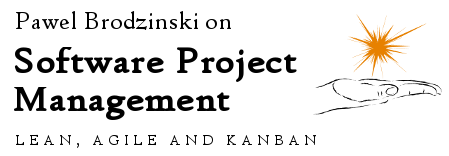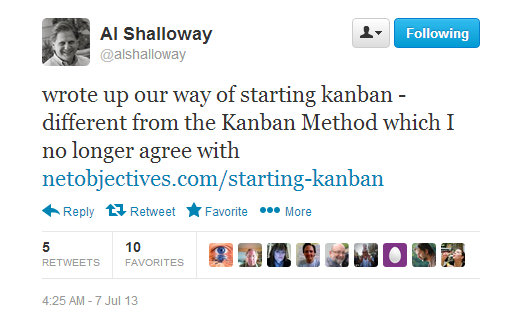Some of you who pay more attention to what is happening in the Lean Kanban community may have noticed that there’s an ongoing discussion about what Kanban is or should be. It’s not about what do we use Kanban for but how exactly we define Kanban.
Another incarnation of this discussion was started by Al Shalloway with his post on how he typically approaches Kanban implementations and the explicit statement that he doesn’t support Kanban method anymore.
Obviously it sprung a heated discussion on Twitter, which is probably the worst possible medium for such a conversation. I mean how precisely can you explain yourself in 140 characters? That’s why I didn’t take part in it. However, since I do care about that here is my take on the whole thing – not just Al’s comments but the whole dispute altogether.
Let me start with the very old discussion about Scrum. I’ve always been a fanboy of ScrumBut. In fact, all sorts of ScrumButs. Not that I don’t see risks attached to using only part of the method (but that’s another story). I just think that any method is some sort of generalization and its application is contextual. It means that specific implementation has to take into account a lot of details that were simply not available or known when the method was defined.
Fast forward to the discussion around Kanban. My general attitude hasn’t changed. When I see more and more different approaches to Kanban adoption I have the same feelings as I had when I’ve seen people experimenting with different Scrum implementations. The more the merrier.
I totally respected, and learned from, the discussion about different order of adoption of Kanban practices that happened last year at Kanban Leadership Retreat. I totally respect, and learn from, Al’s approach as well. There’s no single flavor of Kanban.
The part I don’t respect is dissing other approaches to Kanban adoption. If we want to discuss why something works or doesn’t work let’s do that in a specific context. I guess we will quickly find out that different approaches are valid in different contexts.
So what is the definition of Kanban? Personally I base on the definition of Kanban method as described in David Anderson’s book (including all the later work that will hopefully make its way to the second version of the book). From my experience it is the most commonly used and most widely known. It is also covered extensively with experience reports and derivative work. So if we look for a benchmark, something we universally refer to when talking about Kanban, I think we already have one.
At the same time I’m perfectly OK when I see other flavors of Kanban. As far as we understand the method, why specific practices are there, we can start tweaking it so it fits our specific context better. This is exactly what is happening with Kanban these days. And my take is that it is still the same Kanban, no matter whether one prefers interpretation of David Anderson, Mary Poppendieck, Henrik Kniberg, Hakan Forss, Al Shalloway or someone else (we’ll see more of those, I’m sure). I’m OK with that, no matter that personally I have my preferences across the list.
There are different sorts of Kanban and that’s actually the best part. There is no one-size-fits-all approach and there never will. It is always contextual. And this is why we need diversity.
Personally, I’d love to see these discussions run in such a spirit and not following the “my way is better than yours” line.



 Subscribe RSS feed
Subscribe RSS feed Follow on Twitter
Follow on Twitter Subscribe by email
Subscribe by email



0 comments… add one